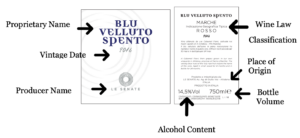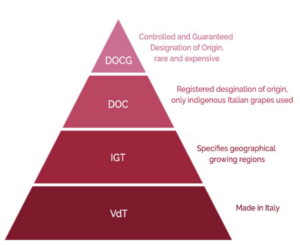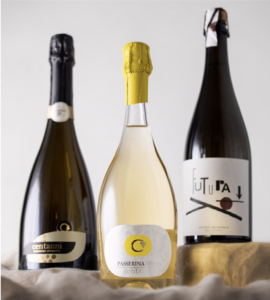Understanding Italian Wine Labels
Foreign wine labels can be difficult to interpret, especially those from Italy. Here are a few tips and terms to help you translate and decipher the info on your bottle.

Understanding Italian Wine Law
DOCG: Is an abbreviation for “Denominazione di Origine Controllata e Garantita”, the top designation for Italian wines. There are very strict rules and regulations that govern all aspects of production, including where the grapes can be grown, what varieties are allowed, as well as the aging process required. A wine must first be designated DOC for at least 5 years before it can qualify to be a DOCG. There are currently only 74 DOCGs in Italy.
DOC: Is an abbreviation for “Denominazione di Origine Controllata”. Just one tier below DOCG, therefore less strict rules and regulations govern production. There are currently 334 DOCs in Italy.
IGT: Is an abbreviation for “Indicazione Geografica Tipica”, or Indicated Geographical Area. This designation allows winemakers the freedom to use grapes, styles, and methods that are not allowed under DOC and DOCG regulations. There are currently 118 IGTs in Italy.
VDT: Is an abbreviation for “Vino di Tavola”, or Table Wine. This term has recently been replaced with just “Vino” but it still means these wines are generally produced from grapes outside of certain boundaries and/or are blends with grapes from different appellations.

Italian Wine Terms
Classico: The Italian word “Classico” means Classic and signifies a wine from a specific zone within a region, such as Chianti Classico.
Riserva: The Italian word “Riserva” means Reserve and signifies a wine has been aged for significantly longer than a non-reserve vintage, however, rules vary among each of the denominations.
Superiore: The Italian word “Superiore” means Superior and signifies a much higher-quality wine with higher alcohol percentages.
Metodo Classico: The Classic Method used to create sparkling wines like Franciacorta, the same method used in the production of Champagne.
Spumante:Sparkling
Frizzante: Slightly Sparkling
Bianco: White
Rosato: Rose’
Rosso: Red
Vigneto: Vineyard
Azienda/Agricola/Tenuta/Podere: Is a farm or estate that produces its own grapes for the production of its wines.
Cantina: Winery
Annata or Vendemmia: Is a specific harvest date or vintage.
Italian Wine Regions
Here is a brief description, as it relates to wine, of Italy’s 20 regions, from north to south.
Northern Italy
Valle d’Aosta
Situated on the borders of France and Switzerland, this is the smallest region in Italy and therefore does not produce much wine. In fact, the region makes such a small quantities of wine very little makes it to the U.S. The primary grapes are Petit Rouge, Pinot Nero, Prié Blanc, and Nebbiolo. This region has no DOCGs or IGPS, and only one DOC, called Valle d’Aosta DOC.
Piemonte
Just below Valle d’Aosta, Piedmont is located at the foot of the western Alps. The region’s most famous grape is Nebbiolo, which is used to make Barolo DOCG, Barbaresco DOCG, Gattinara DOCG, Ghemme DOCG, and Roero DOCG. Two other well-known red grapes, Barbera and Dolcetto, are appreciated for their less expensive price points. Famous white varieties include Gavi DOCG, made from 100% Cortese, as well as, bubbles, like Asti Spumante DOCG and Moscato d’Asti DOCG both made from 100% Moscato. This region has more DOCGs (17) and more DOCs (42) than any other region, yet has no IGPs.
Liguria
Just below Piedmont, along the Mediterranean between France and Tuscany, lies this small and narrow coastal region which produces mostly white varietals made from Vermentino known as Pigato. The primary red grapes are Dolcetto and Rossese. This is the second smallest producer of wines in Italy and rarely do they make it to the US. This region has no DOCGs, 8 DOCs, and 4 IGPs.
Lombardia
Located just east of Piemonte and home to some of the most beautiful lakes in Italy, Lombardia is also the region where I lived in Como for many years. Famous grapes include Chardonnay, Pinot Bianco, and Pinot Nero which are used to produce Franciacorta DOCG, the infamous Italian twin sister to Champagne. For red wines, the famed Nebbiolo grape produces Valtellina Rosso DOC, Valtellina Superiore DOCG and Sforzato di Valtellina DOCG, as well Barbera and Croatina blended to produce Oltrepo’ Pavese DOC. This region has 5 DOCGs, 21 DOCs, and 15 IGPs.
Trentino-Alto Adige
Located on the Swiss and Austrian border which also encompasses a large part of the Dolomites. In fact the entire region is located in the Alps making viticulture more of a challenge. Famous red grapes include Lagrein, Schiava, and Teroldego. Famous white grapes include Chardonnay, Pinot Grigio, and Traminer, better known as Gewürztraminer. This region has no DOCGs, 9 DOCs, and 4 IGPs.
Veneto
Located on the Adriatic Sea, with the alps to the north and Lake Garda to the west, Veneto produces more wine than any other region in Italy due to the worldwide popularity of Pinot Grigio and Prosecco. As for famous red grapes in Veneto, the black grape Corvina is used to produce Amarone della Valpolicella DOCG, Bardolino DOC, Bardolino Superiore DOCG, and Valpolicella DOC. This region has 14 DOCGs, 29 DOCs, and 10 IGPs. Friuli-Venezia Giulia Located in the northeastmost corner of Italy that borders Austria and Slovenia. With a focus on white varietals, the most famous grapes of Friuli are Friulano, Pinot Grigio, Ribolla Gialla, and Sauvignon Blanc. There are no denominations that make red wine exclusively. Merlot is the most planted red grape variety, along with Cabernet Franc and Refosco. This region has 4 DOCGs, 12 DOCs, and 3 IGPs.
Central Italy
Emilia-Romagna
Known as the food capital of the world and also home to my favorite Chef, Massimo Battura, this region is one of the most important wine producers in Italy, however very little is exported to the US. The region is best known for Lambrusco, a sparkling red wine. Grechetto and Trebbiano are the most planted white grapes in this region. This region has 2 DOCGs, 19 DOCs, and 9 IGPs.
Tuscany
Centrally located along the Tyrrhenian Sea to the west coast and stretches inland to the beautiful Tuscan countryside, Tuscany is quite possibly the most known and visited Italian region. The most famous red grape is Sangiovese, used to produce Brunello di Montalcino DOCG, Chianti DOCG, Chianti Classico DOCG, and Vino Nobile di Montepulciano DOCG. The best known white grape is Vernaccia used to produce Vernaccia di San Gimignano DOCG, although Trebbiano is the most plant white grape in Tuscany. This region has 11 DOCGs, 41 DOCs, and 6 IGP’s, the second most after Piedmont.
Umbria
Situated between Tuscany, to the west, and Le Marche, to the east, this small region is known for the red grape Gamay, used to produce Gamay del Trasimeno DOC and Montefalco Sagrantino DOCG. The most famous white grape is Grechetto. This region has 2 DOCGs, 13 DOCs, and 6 IGPs.
Le Marche
Le Marche, or just Marche, is situated along the eastern coast of the Adriatic Sea. The most notable red grapes are Sangiovese and Montepulciano used to produce Rosso Piceno DOC. This region is well known for its white grape varieties Verdicchio, Passerina, and Pecorino. This region has 5 DOCGs, 15 DOCs, and 1 IGP.
Lazio
Home to the capital city of Rome this region’s most known for its red grape is Cesanese. The most popular white grape is Grechetto used to make Orvieto DOC. This region has 3 DOCGs, 27 DOCs, and 6 IGPs.
Abruzzo
Located next to Lazio on the Adriatic side best known for Montepulciano d’Abruzzo DOC, made from the Montepulciano grape, the most planted red grape in this region and Trebbiano d’Abruzzo DOC, the most popular white grape in the region. This region has 2 DOCGs, 7 DOCs, and 8 IGPs.
Molise
Located just below Abruzzo this region is the second smallest in size after Valle d’Aosta. Molise is mostly known for Trebbiano (white) and Montepulciano (red) grapes to produce Biferno DOC wines. Very little, if any, wine is exported to the US from Molise. This region has no DOCGs, 4 DOCs, and 2 IGPs.
Southern Italy
Campania
Located in the southern part of the Italian peninsula, facing the Tyrrhenian Sea. It is best known for the famous Taurasi DOCG and Aglianico del Taburno DOCG, both based on the red grape Aglianico. The most popular white varieties are made from Fiano for Fiano di Avellino DOCG and Greco to produce Greco di Tufo DOCG. This region has 4 DOCs, 15 DOCs, and 10 IGPs.
Basilicata
This small region produces a minuscule amount of wine. Though it has few DOCs, the most famous is Aglianico del Vulture DOC and its big brother Aglianico del Vulture Superiore DOCG, made with the full-bodied black grape Aglianico which is planted in more than half of the vineyards. This region has 1 DOCG, 4 DOCs, and 1 IGP.
Puglia
Puglia forms the heel of the Italian boot along the Adriatic coast. Though it is still not particularly well known, the quality of Puglia wines is continually improving. The region’s primary red grape varieties are Negroamaro, Primitivo, Bombino Nero, Uva di Troia. As for white varieties, Trebbiano is the most popular. This region has 4 DOCGs, 28 DOCs, and 6 IGPs.
Calabria
Known as the toe of the Italian peninsula, Calabria is home to Cirò DOC, which produces mostly reds based on the Gaglioppo grape. The most notable white wines are produced from Greco Bianco for Cirò DOC. This region does not have any DOCGs, 9 DOCs, and 10 IGPs.
Sicily
The largest island in the Mediterranean and produces more white wines than red. Notable red wines are Nero d’Avola, Nerello Mascalese, and Frappato. Sicilian white varieties include Grillo, the most planted variety, Ansonica, and Greciano Dorato. This region has 1 DOCG, 23 DOCs, and 7 IGPs.
Sardinia
This beautiful island in the Mediterranean is better known for its crystal clear water, mega yachts, and Pecorino cheese more than wine. The primary red grape is Cannonau, the local name for Grenache. Other notable varieties include Carignano and Monica. Vermentino used to produce Vermentino di Gallura DOCG and Nuragus di Cagliari DOC is the most famous white variety. This region has 1 DOCG, 17 DOCs, and 15 IGPs.
Italian Wine Zones of Yours Truly Wine
Tuscany
Brunello di Montalcino DOCG and Rosso di Montalcino DOC
The area around the town of Montalcino is famous for their high quality Sangiovese grapes, known in Montalcino as Brunello grapes. This variety of grape is used to produce Italy’s finest wine, Brunello di Montalcino DOCG and its baby brother Rosso di Montalcino DOC. There are only around 4000 acres of vineyards in the Brunello denomination and only around 200 producers.
DOCG regulations state Brunello di Montalcino DOCG must be produced using 100% Brunello, (Sangiovese), grapes grown within the commune of Montalcino. This wine must contain a minimum of 12.5% alcohol level. It must be aged for a minimum of two years in barrels and a minimum of two years in the bottle, a total minimum of fours years before this wine can be released. Brunello producers make less than 800,000 cases of wine annually.
To learn more about our two female winemakers of Brunello di Montalcino DOCG, Scopeto di Cavalli and Madonna Nera click here.
Orcia DOC
In the heart of Tuscany lies a beautiful valley called Val d’Orcia. It is only in this area, made up of twelve municipalities, where Orcia DOC wines may be produced. It was only fairly recently, February 14, 2000, this area was designated with this denomination thanks to the high quality of wine produced in this territory. There are roughly around 300 acres and only 40 producers.
DOC regulations state Orcia DOC red wines must consist of a minimum of 60% Sangiovese and may be blended with additional grapes approved by the Region of Tuscany. Orcia Riserva Orcia DOC must be aged a minimum of 24 months, of which 12 months must be aged in barrels. Orcia Sangiovese DOC must be made from Sangiovese (minimum 90%) and a maximum of 10% grapes of Canaiolo Nero, Colorino, Ciliegiolo, Foglia Tonda, Pugnitello, and/or Malvasia Nera. In addition to be an Orcia Sangiovese Riserva DOC the wine must be aged for at least 30 months, of which at least 24 months are aged in oak barrels. Orcia DOC producers make only 23,400 cases per year on average.
Toscana IGT -Established in 1995, the Toscana IGT designation includes all grape varieties grown within the region of Tuscany which comprises 32,945 acres with an average annual production of a little over 7,000,000 cases. The consortiums regulations are listed below by grape variety. There are no aging regulations, however, there is an alcohol level minimum of 10% for white wines, and 11% for rosato and red wines.
Bianco Toscana IGT may contain any proportions of grape varieties approved for the region of Toscana
Rosato Toscana IGT may contain any proportions of grape varieties approved for the region of Toscana
Rosso Toscana IGT may use any proportions of grape varieties approved by the region of Toscana
We currently work with three producers in this territory, Capitoni, Podere Albiano, and Poggio Grande. To learn more about these wineries located in Val d’Orcia click here.
Umbria
Trasimeno DOC
Near the picturesque shores of Lake Trasimeno, in the Perugia, you find only 12 wineries registered and able to use the designation Trasimeno DOC, established in 1972. The zone is made up of 10 small towns situated near the lake. There are 548 acres of vineyards which produce an average annual production of around 28,000 cases.
Trasimeno DOC regulations there must use a minimum of 85% of the grape named on the label plus other allowable grapes by the region of Umbria in order to have the designation. For example, Gamay Trasimeno DOC must have a minimum of 85% Grenache plus other allowable red grapes. Blends have several different regulations depending on the variety.
Umbria IGT
The entire area of approximately 7000 acres in Umbria make up the Umbria IGT territory and produces on average 1,000,000 cases per year. The denomination does not have any aging requirements. The regulations are listed below by variety.
Bianco Umbria IGT may contain any proportions of grape varieties approved for the region of Umbria
Rosato Umbria IGT may contain any proportions of grape varieties approved for the region of Umbria
Rosso Umbria IGT may use any proportions of grape varieties approved by the region of Umbria To learn more about our Umbrian winery, Madrevite, click here.
Le Marche Offida DOCG and Offida DOC
This zone is an interesting area known as Offida DOCG and Offida DOC, in which winemakers may use the white grapes of Pecorino and Passerina, or red grapes of Montepulciano. Offida DOC was established in 2001. It was not until 2011 when Offida DOCG was created. Each variety must contain a minimum of 85% of the named grape. The white varieties must be aged for a minimum of 4 months. Montepulciano must be aged for a minimum of 24 months. There are roughly 1000 acres with 44 winemakers and an annual production of 184,700 cases.
Falerio DOC
Falerio DOC consist of 953 acres and produces 275,000 cases annually. It must contain 20– 50% Trebbiano, 10–30% Passerina, 10–30% Pecorino, along with a maximum 20% other allowable white grapes. To learn more about our Falerio DOC winemakers click here.
Rosso Piceno DOC
Rosso Piceno DOC has 311 acres and produces 23,400 cases on average annually. This wine must contain 35–85% Montepulciano, 15–50% Sangiovese, and a maximum of 15% of other allowable red grapes. To learn more about our Rosso Piceno DOC winemaker click here.
Marche IGT
The only IGT in Marche is made up of around 3000 acres and produces an average annual production of 1,450,000 cases. Below is a list of regulation a winemaker must follow in order to have this designation.
Bianco may contain any proportions of grape varieties approved for the region of Marche
Rosato may contain any proportions of red grape varieties approved for the region of Marche
Rosso may contain any proportions of red grape varieties approved for the region of Marche
Bianco Spumante – Same as Bianco
Rosato Spumante – Same as Rosato
Rosso Spumante – Same as Rosso
Abruzzo
Colle Aprutini IGT
Numerous communes in the province of Teramo make up the denomination Colle Aprutini IGT which covers approximately 550 acres of vineyards and produces an average annual production of 244,000 cases.
Bianco may contain any proportions of grape varieties approved for the region of Abruzzo
Rosato may contain any proportions of grape varieties approved for the region of Abruzzo
Rosso may contain any proportions of grape varieties approved for the region of Abruzzo






